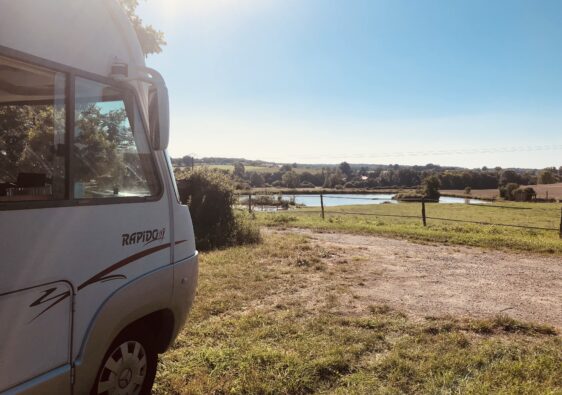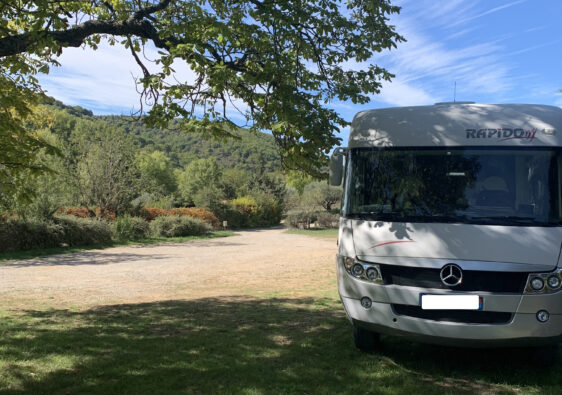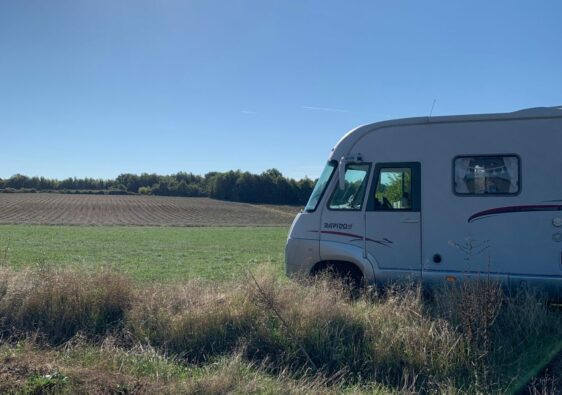⚠️ This article was originally written for driving in France. Depending on your country, some parts may not apply.
Driving a motorhome requires some knowledge to adapt your driving to this type of vehicle. While driving a van or a camper van may resemble driving your everyday vehicle, stepping up to a motorhome means transitioning to a different kind of vehicle: it’s longer, wider, heavier… in short, more cumbersome!
In this article, we’ll address the main questions that arise for those who are inexperienced in driving such vehicles, such as those considering buying their first motorhome. Enough chit-chat, let’s get started!
Is driving a motorhome difficult?
This is THE question every prospective motorhome owner asks. Our answer is that there’s no particular difficulty in driving a motorhome, although the size of some vehicles may initially be daunting! It simply requires adjusting your driving to the vehicle: you don’t drive a motorhome like you drive a city car.
So, while there’s no inherent difficulty, we’ll explore in this article the important considerations when it comes to driving a motorhome, to anticipate challenges and avoid tricky situations 😉
Can I drive a motorhome with a regular driver’s license (Class B)?
A regular Class B driver’s license is sufficient for driving the vast majority of motorhomes (under 3.5 tonnes). A commercial driver’s license (Class C) is required for vehicles over 3.5 tonnes, focusing on specific aspects like advanced braking techniques and complex maneuvers.
Note that there are no specific regulations for young drivers, but it’s advisable to gain sufficient experience before embarking on motorhome driving!
Additionally, adding a trailer may necessitate adjustments to prerequisites: for instance, a motorhome towing a trailer with a GTW (Gross Trailer Weight) of less than 750 kg may require a Class BE license.
What are the constraints of a motorhome?
Here are the three main constraints of traveling in a motorhome, as we see them:
- Vehicle size: Due to its dimensions and weight, maneuvering a motorhome can be challenging, especially in tight spaces or on narrow roads. It’s wise to think ahead before venturing onto small country roads 😉
- Parking: Some places have specific restrictions on motorhome parking, which may require parking further away from the desired visitation sites.
- Fuel consumption and maintenance costs: A motorhome generally consumes more fuel than your everyday car, typically averaging between 10 to 15 liters per 100 kilometers on highways! Maintenance costs also need consideration: while routine maintenance of the chassis is generally reasonable, consumables like tires can be significantly more expensive. Additionally, there’s maintenance for the living quarters, such as regular checks for waterproofing, which can quickly add up to a substantial budget!

What are the basic rules and what should you pay attention to?
It’s crucial to always keep in mind a few basic rules when traveling in a motorhome. Here are the ones that we find essential:
- The first rule is obviously to always consider the dimensions of the vehicle. This involves respecting size (and weight) limitations: being aware of your vehicle’s size while driving is paramount, and paying close attention to height and width restriction signs is a must!
- Drive cautiously and anticipate as much as possible: a motorhome requires more time to accelerate, brake, and negotiate tight turns.
- Always adhere to parking regulations: it’s essential to check local parking rules whenever you plan to park; motorhomes cannot park anywhere to avoid causing obstruction. Interestingly, it’s common to find cars parked in spaces designated for motorhomes 😉
- Organize your living space well and limit the weight of your belongings: to maximize comfort on board, there’s a temptation to bring along various items and accessories. However, it’s important to remember that their cumulative weight can significantly affect the total weight of the vehicle! Therefore, restrict items to the essentials wherever possible to avoid overloading your vehicle. On the bright side, it will lead to lower fuel consumption 😄
- Security and the risk of theft: close the curtains! Don’t leave laptops, cameras, or other valuables lying around on the table when your motorhome is parked. If you prefer not to always close the blinds at the dashboard level, you can simply install a curtain behind the seats to hide the contents of the living area.
- Regular vehicle maintenance is crucial: this involves regularly checking fluid levels, tire condition, tire pressure, etc…
- Careful management of onboard resources: water and electricity require particular attention to avoid running out unexpectedly; here are our tips for optimal autonomy.
- Plan your routes to avoid roads unsuitable for the vehicle’s dimensions, which also helps save fuel: by planning your routes in advance, for instance, you can bypass mountainous areas.

How to drive a motorhome properly?
As we’ve just discussed, a motorhome driver must always keep in mind that they are handling a vehicle whose weight and dimensions differ significantly from those of a standard car.
Driving well starts with careful anticipation: due to its weight, a motorhome requires a longer braking distance. It’s essential to anticipate braking early and maintain a safe distance from other vehicles. It’s worth noting that most motorhomes are built on van chassis such as Ducato, Transit, Sprinter, which are originally vans to which a living space of over a ton has been added! Therefore, driving must be adjusted to accommodate this significant additional weight.
When navigating hilly terrain, it’s crucial to adjust your driving to the landscape: when climbing, maintain a moderate speed to avoid overheating; when descending, utilize engine braking to minimize strain on the brakes.

A motorhome typically stands at a height of 3 meters, which results in significant wind resistance on the road. During strong gusts or when passing a heavy vehicle, the motorhome can experience substantial lateral forces that cause it to sway. It’s crucial to remain vigilant and grip the steering wheel firmly with both hands to maintain control and avoid veering off course.
Furthermore, weather conditions play a significant role in driving: reduce speed in rainy or windy conditions to ensure safety.
In summary: always consider the dimensions of your motorhome while driving! Be mindful of the road’s height restrictions before proceeding on any route!
Is driving a motorhome challenging in the mountains?
Let’s break it down between uphill and downhill driving!
- Uphill: It’s important to be gentle with your engine by finding the right cruising rhythm. Maintain sufficient engine power while keeping the RPM moderate. Remember, the chassis is carrying hundreds of kilograms, so it’s crucial to be considerate to prevent overheating once you reach the summit 🥵.
- Downhill: While one might think “the hard part is over,” downhill requires heightened vigilance. Managing several tons descending at an 8% grade or more demands careful handling. Maximize engine braking and use regular, gentle brake applications to avoid overheating and prevent brake fade—where reduced friction coefficient due to heating reduces braking effectiveness.
Parking and maneuvering with a motorhome:
Parking can be challenging even with a van or converted camper, and it’s even more so with a motorhome!
Apart from height restrictions in parking lots, finding a sufficiently sized spot for your vehicle is crucial.
Personally, we try to plan our parking in advance. Before hitting the road, it’s best to have a destination in mind and preferably a backup plan in case the initial parking spot isn’t available. This helps avoid aimless searching and unnecessary maneuvers.

Similarly, when visiting a city, even if you manage to find a spot close to the center not occupied by cars, it’s important to note that motorhomes are typically “parked” in outskirts of city centers. Again, you can plan ahead by researching public transportation options, whether in France or abroad (like when we visited Salzburg, for example). Public transportation offers many advantages over trying to park a motorhome in prime spots, to the frustration of other drivers 🙂
Once you find a suitable parking spot, it’s common for it to be crowded with cars! Unfortunately, as far as we know, regulations don’t prohibit cars from parking in motorhome areas…
What are the rules for loading and weight distribution?
The rule is straightforward: for motorhomes up to 3.5 tons, the total weight of the vehicle including passengers, full tanks, and loaded cargo must not exceed 3.5 tons! Considering the average empty weight of a motorhome is around 3 tons, that leaves “only” 500 kg of payload, including passengers!
Knowing this, it’s better to optimize each item you bring to maximize total weight: forget the 50 kg umbrella stand and only take what’s absolutely necessary. Check out our article listing the top 10 essentials for motorhomes.
Regarding distribution, a few simple rules apply: distribute weight evenly throughout the vehicle to avoid imbalance that could affect handling. Also, place heavy items lower and towards the center of the vehicle for stability.
How to check a motorhome before a trip?
Before hitting the road, it’s important to perform several checks on your motorhome:
- Check tire pressure and inspect tire condition.
- Oil level: top up if necessary, especially if you’re planning a long journey of several hundred kilometers.
- Inspect windshield wipers and washer fluid level: stubborn bugs on a large motorhome windshield can be quite a hassle 🦟.
- Plug in your vehicle 24 hours before departure to allow the batteries to charge.
- If you have a solar panel, ensure it’s perfectly clean.
Depending on the season, check that the heating system is working properly to avoid being without heat at the first stop of your journey!
What are the tips for driving a motorhome in challenging weather conditions?
In a motorhome, wind resistance is significant, and every side gust is strongly felt. The vehicle tends to sway from its trajectory, so extra vigilance is needed to keep it as straight as possible. Headwinds also significantly impact fuel consumption: driving several tens of kilometers into a headwind can lead to an increase in consumption by a few extra liters… However, tailwinds are always appreciated!
In heavy rain, it’s advisable to adjust your speed to account for longer braking distances. Maintain a safe distance from vehicles ahead, and if the rain becomes too intense, consider stopping and waiting for conditions to improve!
What are the specific speed limits for motorhomes?
For all motorhomes requiring only a standard B license, which is the vast majority, the speed limits are the same as those for regular cars. However, it’s advisable to drive cautiously, considering the size of the vehicle, and not hesitating to drive slightly below the limits.
For heavier motorhomes, they are subject to lower speed limits:
- 110 km/h on highways
- 100 km/h on dual carriageways separated by a central reservation
- 80 km/h on other roads
It’s important to note that additional specific rules apply to heavier motorhomes:
- Certain restrictions on urban driving with required detours based on weight
- No overtaking in certain sections
- Increased safety distances from the vehicle ahead
- Obligation to stay in the right lane in roundabouts
- And more…
We hope this article addresses some of your questions regarding driving motorhomes. If you have any further inquiries, feel free to ask us in the comments!






